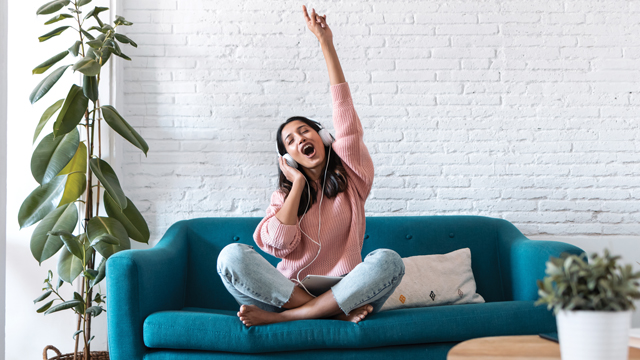As a music therapist, I often use music to address goals in therapy. One thing I frequently hear from kids and teenagers, as well as their parents, is that they wish they could connect more with each other, but they don’t know what to talk about. Here are some ways to use music at home to connect with people you care about:
1. Use a song trade to get a glimpse into each other’s world.
Sometimes it’s hard to relate to each other, and we don’t know what to talk about. Music gives us an opportunity to approach each other with curiosity and respect, which is important to any relationship and loving interaction.
Here’s how a song trade works. You and your child, partner, or friend, each choose a song and sit and listen to both songs together. Set up this experience for success by establishing guidelines. If you roll your eyes, scoff at the lyrics, check your phone, or talk over the other person’s song, you’re blowing it. Explain that you want to sit quietly for the length of each song and really take in the music together. Look up the lyrics and read them together. Find something you like about the other person’s song and let him or her know. Maybe you love the bass line, maybe there’s one catchy phrase. Ask open-ended questions like, “What’s your favorite part of the song?” Music is a part of our identity, so honor that without judgment.
If you’re doing this with kids, you want to be mindful of how you approach this activity to set it up for success. If your child wants you to go first, read the room. What is the mood? It would be nice to match it. If your child goes first, try to match the mood of her song. If she shares a fun dance song, share one you’ve enjoyed (maybe even when you were her age!), and show her your favorite dance moves to it. Be silly and take the opportunity to play together. If she chooses a sad song for the trade, don’t try to fix the sadness or change to a happy song. Just be with it for a moment with her. Offer a hug. Then show her a song you have related to when you’re sad. This can be a vulnerable experience, and vulnerability allows us to feel closer to each other because we feel let in. You might even share something (a healthy coping skill) you do for yourself when you feel sad, like going for a walk or taking a bath.
Troubleshooting: It’s likely that this will be a fun and light activity, but if the song is very sad, acknowledge it with kindness. If the song has mature content in it, be gentle in your response. Whatever happens, your child is likely sharing something sacred with you, and it’s best to treat it as such.
2. Use dance to engage around music.
I realize this requires a willingness of both parties to do that scary thing that a lot of people avoid at all costs: dancing. But dancing releases endorphins, dopamine, serotonin, and oxytocin. Each of these chemicals makes us feel good. In fact, oxytocin is what bonds us to our children (and other people) in the first place. It helps to facilitate empathy and trust, which is important to relationships. It doesn’t matter what the song is, and it doesn’t matter what the moves are. Take turns making up the dumbest dance moves you can think of, imitate each other, and try dancing in sync.
Troubleshooting: Establish beforehand that no one can make fun of anyone else’s moves. This is a safe space. No videos. No social media. Relax and laugh with your kids. Get them to teach you how to do it. Whatever you do, don’t shame them.
3. Use music to keep track of time and to make any activity more fun.
It’s easier to start something when we know how long it will last. Rhythm and melody can transform a moment into something energizing, grounding, or calming. There are some ways you can use music mindfully around the home and with your kids to enjoy its benefits.
a. Clean for twenty minutes and make a fun playlist for it.
b. Make a playlist for a morning car ride to help everyone feel: 1) less anxious, 2) more awake, or 3) calm and centered and ready for the day. When you do something to intentionally prepare for the day, you’re more prepared to deal with what will come. The day often goes better as a result. Try it.
c. Choose new albums to listen to during a longer road trip (is there a vacation in your future?). Everyone in the car gets to choose an album.
d. Sit quietly for ten minutes and listen to a playlist. You might start with sitting still for one song with the option of building from there. It’s more difficult than you think. We are all used to a lot more stimulation these days. Make sure you frame this as reflective meditation and not punishment. Stillness is important and shouldn’t only happen when kids are in trouble.
e. Make a ten-minute dance and movement playlist for after school or work to shake out the day. Movement helps us release stress. This also models for your child an important coping skill, which is to make an effort to actively reduce stress daily.
Troubleshooting: Try not to let making a playlist become a stressful or tedious ordeal. You don’t have to make a new playlist each time you do an activity. Everyone’s music gets equal air-time.
As you’ve probably noticed, music is not the main point here. With each of these activities, music is present to serve a bigger purpose. It’s a means to connect with people we love, relieve stress, and improve quality of life. I invite you to use music intentionally at home and see what happens.




